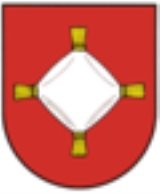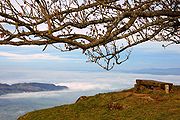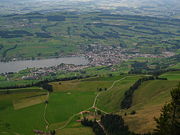
Küssnacht
Encyclopedia
Küssnacht am Rigi is a district
and municipality
in the canton
of Schwyz in Switzerland
, consisting of three villages: Küssnacht, Immensee and Merlischachen. It is situated at the north shore of Lake Lucerne
and at the south shore of Lake Zug below mount Rigi
(1797 m (5,895.7 ft)).
In 1424 Küssnacht became a district of the Canton of Schwyz.
According to the legend of Wilhelm Tell
, the hero shot the Austrian
bailiff
Gessler
at the Hohle Gasse near the Gesslerburg with his crossbow
.
On August 29, 1935, Queen Astrid of the Belgians was killed here in a road accident.
A memorial chapel ("Königin-Astrid-Kapelle") was built at the accident scene.
The well known Klausjagen
("Nicholas
chase") festival takes place in Küssnacht every year on the eve of St. Nicholas Day (December 5). The festival, attended by about 20,000 people, consists of a parade of around 1,000 participants, and lasts far into the night.

 Küssnacht has an area, , of 29.5 km² (11.4 sq mi). Of this area, 57.5% is used for agricultural purposes, while 27% is forested. Of the rest of the land, 14.1% is settled (buildings or roads) and the remainder (1.4%) is non-productive (rivers, glaciers or mountains).
Küssnacht has an area, , of 29.5 km² (11.4 sq mi). Of this area, 57.5% is used for agricultural purposes, while 27% is forested. Of the rest of the land, 14.1% is settled (buildings or roads) and the remainder (1.4%) is non-productive (rivers, glaciers or mountains).
The municipality is at the foot the Rigi mountain between the Lake of Lucerne and Lake Zug. It consists of the villages of Küssnacht, Immensee and Merlischachen as well as the hamlets
of Haltikon and Seebodenalp.
It is the capital and only municipality of the district of Küssnacht.
the gender distribution of the population was 50.5% male and 49.5% female. The age distribution, , in Küssnacht is; 2,707 people or 25.3% of the population is between 0 and 19. 3,168 people or 29.6% are 20 to 39, and 3,406 people or 31.8% are 40 to 64. The senior population distribution is 775 people or 7.2% are 65 to 74. There are 477 people or 4.5% who are 70 to 79 and 171 people or 1.60% of the population who are over 80. There are 3 people who are over 100 years old in Küssnacht.
there are 4,377 households, of which 1,387 households (or about 31.7%) contain only a single individual. 271 or about 6.2% are large households, with at least five members.
In the 2007 election the most popular party was the SVP
which received 36.3% of the vote. The next three most popular parties were the CVP
(25.6%), the FDP
(21.6%) and the SPS
(12.1%).
The entire Swiss population is generally well educated. In Küssnacht about 72.9% of the population (between age 25-64) have completed either non-mandatory upper secondary education or additional higher education (either university or a Fachhochschule
).
Küssnacht has an unemployment rate of 1.62%. , there were 344 people employed in the primary economic sector and about 125 businesses involved in this sector. 2,340 people are employed in the secondary sector and there are 153 businesses in this sector. 3,135 people are employed in the tertiary sector, with 486 businesses in this sector.
From the , 7,891 or 73.7% are Roman Catholic, while 1,152 or 10.8% belonged to the Swiss Reformed Church
. Of the rest of the population, there are less than 5 individuals who belong to the Christian Catholic
faith, there are 146 individuals (or about 1.36% of the population) who belong to the Orthodox Church, and there are 17 individuals (or about 0.16% of the population) who belong to another Christian church. There are less than 5 individuals who are Jewish
, and 501 (or about 4.68% of the population) who are Islam
ic. There are 76 individuals (or about 0.71% of the population) who belong to another church (not listed on the census), 563 (or about 5.26% of the population) belong to no church, are agnostic
or atheist
, and 354 individuals (or about 3.31% of the population) did not answer the question.
The historical population is given in the following table:
Districts of Switzerland
In contrast to centrally organised states, in the federally constituted Switzerland each canton iscompletely free to decide its own internal organisation. Therefore there exists a variety of structures and terminology for the subnational entities between canton and municipality, loosely termed...
and municipality
Municipalities of Switzerland
Communes , also known as municipalities, are the smallest government division in Switzerland, numbering 2,596 . While many have a population of a few hundred citizens, the largest cities such as Zürich or Geneva also have the legal status of municipalities...
in the canton
Cantons of Switzerland
The 26 cantons of Switzerland are the member states of the federal state of Switzerland. Each canton was a fully sovereign state with its own borders, army and currency from the Treaty of Westphalia until the establishment of the Swiss federal state in 1848...
of Schwyz in Switzerland
Switzerland
Switzerland name of one of the Swiss cantons. ; ; ; or ), in its full name the Swiss Confederation , is a federal republic consisting of 26 cantons, with Bern as the seat of the federal authorities. The country is situated in Western Europe,Or Central Europe depending on the definition....
, consisting of three villages: Küssnacht, Immensee and Merlischachen. It is situated at the north shore of Lake Lucerne
Lake Lucerne
Lake Lucerne is a lake in central Switzerland and the fourth largest in the country.The lake has a complicated shape, with bends and arms reaching from the city of Lucerne into the mountains. It has a total area of 114 km² , an elevation of 434 m , and a maximum depth of 214 m . Its volume is 11.8...
and at the south shore of Lake Zug below mount Rigi
Rigi
- Mt. Rigi in Art:Mt. Rigi has been featured in many works of art, including both paintings and literary publications. Perhaps the most famous paintings of the Rigi were by JMW Turner, including "The Blue Rigi, Lake of Lucerne, Sunrise"...
(1797 m (5,895.7 ft)).
History
Küssnacht is first mentioned around 840 as in Chussenacho though this is from an 11th Century copy of the original document. In 1179 it was mentioned as Chussenacho.In 1424 Küssnacht became a district of the Canton of Schwyz.
According to the legend of Wilhelm Tell
William Tell
William Tell is a folk hero of Switzerland. His legend is recorded in a late 15th century Swiss chronicle....
, the hero shot the Austrian
Austrians
Austrians are a nation and ethnic group, consisting of the population of the Republic of Austria and its historical predecessor states who share a common Austrian culture and Austrian descent....
bailiff
Vogt
A Vogt ; plural Vögte; Dutch voogd; Danish foged; ; ultimately from Latin [ad]vocatus) in the Holy Roman Empire was the German title of a reeve or advocate, an overlord exerting guardianship or military protection as well as secular justice...
Gessler
Albrecht Gessler
Albrecht Gessler was a probably legendary Habsburg bailiff at Altdorf, whose brutal rule led to the William Tell rebellion and the eventual independence of the Swiss Confederacy....
at the Hohle Gasse near the Gesslerburg with his crossbow
Crossbow
A crossbow is a weapon consisting of a bow mounted on a stock that shoots projectiles, often called bolts or quarrels. The medieval crossbow was called by many names, most of which derived from the word ballista, a torsion engine resembling a crossbow in appearance.Historically, crossbows played a...
.
On August 29, 1935, Queen Astrid of the Belgians was killed here in a road accident.
A memorial chapel ("Königin-Astrid-Kapelle") was built at the accident scene.
The well known Klausjagen
Klausjagen
The Klausjagen festival takes place in the Swiss town of Küssnacht on the eve of St. Nicholas Day. The festival, attended each year by about 20,000 people, consists of a parade of around 1,000 participants, and lasts far into the night....
("Nicholas
Saint Nicholas
Saint Nicholas , also called Nikolaos of Myra, was a historic 4th-century saint and Greek Bishop of Myra . Because of the many miracles attributed to his intercession, he is also known as Nikolaos the Wonderworker...
chase") festival takes place in Küssnacht every year on the eve of St. Nicholas Day (December 5). The festival, attended by about 20,000 people, consists of a parade of around 1,000 participants, and lasts far into the night.
Geography


The municipality is at the foot the Rigi mountain between the Lake of Lucerne and Lake Zug. It consists of the villages of Küssnacht, Immensee and Merlischachen as well as the hamlets
Hamlet (place)
A hamlet is usually a rural settlement which is too small to be considered a village, though sometimes the word is used for a different sort of community. Historically, when a hamlet became large enough to justify building a church, it was then classified as a village...
of Haltikon and Seebodenalp.
It is the capital and only municipality of the district of Küssnacht.
Demographics
Küssnacht has a population (as of ) of . , 19.1% of the population was made up of foreign nationals. Over the last 10 years the population has grown at a rate of 11.5%. Most of the population speaks German (87.5%), with Albanian being second most common ( 2.7%) and Serbo-Croatian being third ( 2.7%).the gender distribution of the population was 50.5% male and 49.5% female. The age distribution, , in Küssnacht is; 2,707 people or 25.3% of the population is between 0 and 19. 3,168 people or 29.6% are 20 to 39, and 3,406 people or 31.8% are 40 to 64. The senior population distribution is 775 people or 7.2% are 65 to 74. There are 477 people or 4.5% who are 70 to 79 and 171 people or 1.60% of the population who are over 80. There are 3 people who are over 100 years old in Küssnacht.
there are 4,377 households, of which 1,387 households (or about 31.7%) contain only a single individual. 271 or about 6.2% are large households, with at least five members.
In the 2007 election the most popular party was the SVP
Swiss People's Party
The Swiss People's Party , also known as the Democratic Union of the Centre , is a conservative political party in Switzerland. Chaired by Toni Brunner, but spearheaded by Christoph Blocher, the party is the largest party in the Federal Assembly, with 58 members of the National Council and 6 of...
which received 36.3% of the vote. The next three most popular parties were the CVP
Christian Democratic People's Party of Switzerland
The Christian Democratic People's Party of Switzerland is a Christian democratic political party in Switzerland. It is the fourth-largest party in the National Council, with 31 seats, and the largest in the Council of States, with 15 seats. It has one seat, that of Doris Leuthard, on the Swiss...
(25.6%), the FDP
Free Democratic Party of Switzerland
The Free Democratic Party was a classical liberal political party in Switzerland. It was one of the major parties in Switzerland until its merger with the smaller classical liberal Liberal Party, to form FDP.The Liberals on 1 January 2009....
(21.6%) and the SPS
Social Democratic Party of Switzerland
The Social Democratic Party of Switzerland is the largest centre-left political party in Switzerland....
(12.1%).
The entire Swiss population is generally well educated. In Küssnacht about 72.9% of the population (between age 25-64) have completed either non-mandatory upper secondary education or additional higher education (either university or a Fachhochschule
Fachhochschule
A Fachhochschule or University of Applied Sciences is a German type of tertiary education institution, sometimes specialized in certain topical areas . Fachhochschulen were founded in Germany and later adopted by Austria, Liechtenstein, Switzerland and Greece...
).
Küssnacht has an unemployment rate of 1.62%. , there were 344 people employed in the primary economic sector and about 125 businesses involved in this sector. 2,340 people are employed in the secondary sector and there are 153 businesses in this sector. 3,135 people are employed in the tertiary sector, with 486 businesses in this sector.
From the , 7,891 or 73.7% are Roman Catholic, while 1,152 or 10.8% belonged to the Swiss Reformed Church
Swiss Reformed Church
The Reformed branch of Protestantism in Switzerland was started in Zürich by Huldrych Zwingli and spread within a few years to Basel , Bern , St...
. Of the rest of the population, there are less than 5 individuals who belong to the Christian Catholic
Christian Catholic Church of Switzerland
The Christian Catholic Church of Switzerland is the Swiss member church of the Union of Utrecht, also known as Old Catholic Church, originally founded by the jansenists, with a later influx of discontented Catholics following their disappointment with the First Vatican Council. It has 14,000...
faith, there are 146 individuals (or about 1.36% of the population) who belong to the Orthodox Church, and there are 17 individuals (or about 0.16% of the population) who belong to another Christian church. There are less than 5 individuals who are Jewish
Judaism
Judaism ) is the "religion, philosophy, and way of life" of the Jewish people...
, and 501 (or about 4.68% of the population) who are Islam
Islam
Islam . The most common are and . : Arabic pronunciation varies regionally. The first vowel ranges from ~~. The second vowel ranges from ~~~...
ic. There are 76 individuals (or about 0.71% of the population) who belong to another church (not listed on the census), 563 (or about 5.26% of the population) belong to no church, are agnostic
Agnosticism
Agnosticism is the view that the truth value of certain claims—especially claims about the existence or non-existence of any deity, but also other religious and metaphysical claims—is unknown or unknowable....
or atheist
Atheism
Atheism is, in a broad sense, the rejection of belief in the existence of deities. In a narrower sense, atheism is specifically the position that there are no deities...
, and 354 individuals (or about 3.31% of the population) did not answer the question.
The historical population is given in the following table:
| year | population |
|---|---|
| 1743 | 1,506 |
| 1799 | 1,987 |
| 1850 | 2,788 |
| 1900 | 3,562 |
| 1950 | 5,680 |
| 1970 | 7,956 |
| 1980 | 8,203 |
| 1985 | 8,676 |
| 1990 | 9,437 |
| 2000 | 10,908 |
| 2005 | 11,639 |
| 2007 | 11,870 |

